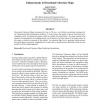Free Online Productivity Tools
i2Speak
i2Symbol
i2OCR
iTex2Img
iWeb2Print
iWeb2Shot
i2Type
iPdf2Split
iPdf2Merge
i2Bopomofo
i2Arabic
i2Style
i2Image
i2PDF
iLatex2Rtf
Sci2ools
WSCG
2001
2001
Enhancements to Directional Coherence Maps
Directional Coherence Maps as proposed by Guo in '98 are a very efficient acceleration technique for ray tracing based global illumination renderers. It vastly reduces the number of pixels which have to be computed exactly by identifying regions which are suitable for interpolation. By using oriented finite elements for interpolation, the sampling density can be kept low for large regions of the target image. In this paper we describe extensions of the method. An improved object test is presented which prevents that small objects are missed. Additionally, it is shown how to handle textures efficiently, which was not possible with the original approach.
Directional Coherence Maps | Efficient Acceleration Technique | Global Illumination Renderers | WSCG 2001 |
| Added | 31 Oct 2010 |
| Updated | 31 Oct 2010 |
| Type | Conference |
| Year | 2001 |
| Where | WSCG |
| Authors | Annette Scheel, Marc Stamminger, Jörg Pütz, Hans-Peter Seidel |
Comments (0)

